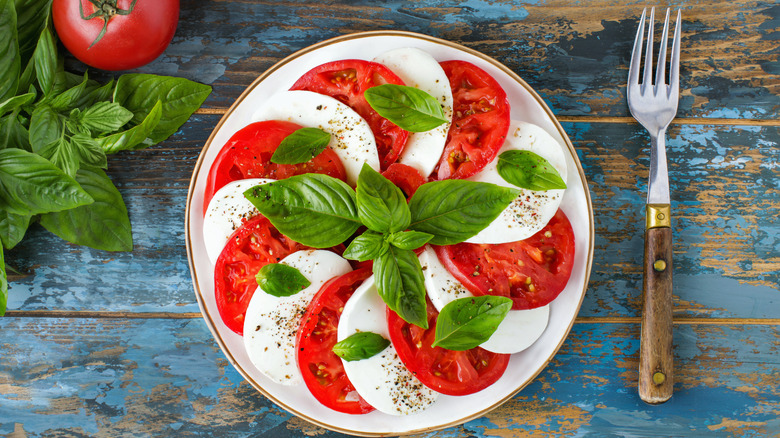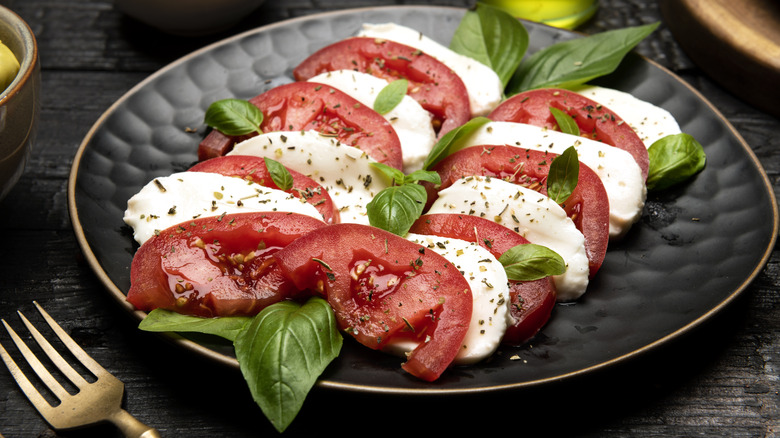Ina Garten's Advice For Fixing Messy Caprese Salads
Caprese salad is such a simple dish, yet each bite just bursts with flavor. With only three main ingredients — tomatoes, mozzarella cheese, and basil — the colors of the Italian flag evinced on the plate are as lovely to look at as they are satisfying to eat. And that's where things can get tricky. Slippery tomatoes and wet, soft cheese can be hard to work with, leading to a messy presentation. It can be difficult to make this dish look as nice as it tastes. Thank the stars, we've got the Barefoot Contessa herself, Ina Garten, providing tips on how to fix up a caprese salad as less of a mess and more like a work of art. The biggest tip? Keeping tomatoes and cheese uniform in size.
In her "Ask Ina" series on Instagram, Garten walks us through the step-by-step process. She approaches the task as if from the perspective of a designer, explaining the importance of balanced proportions and attractive plating. She walks us through everything from how to properly slice the tomatoes and cheese, several ways to use basil, and in what order to add the seasonings. With such a minimalist recipe, quality and care are everything. Treat caprese as you would carpaccio or sashimi ... the raw ingredients are highlighted so that you can really taste and appreciate them. Caprese is at its best when thoughtfully arranged with regard to its individual components, and this comes through in how it looks when served.
The fine art of mouthwatering food arrangement
The first bit of caprese wisdom Ina Garten imparts is to use similar sizes of tomato and mozzarella. By keeping them the same diameter and thickness, you end up with a much neater overall appearance. To get those clean slices, you need to use the appropriate kind of knife. For tomatoes, use a serrated knife to prevent tearing and juice from squirting everywhere. For the mozzarella, opt for a soft cheese knife, boning knife, or cheese wire (if not available, a sharp, thin knife is fine). Garten uses a slicing knife, and her slices look to be a good ¼ inch in thickness.
Before assembling, you'll want to give some careful consideration to the plate or platter you'll be using. Do the colors match the food? Is the size too big or not big enough? Is the shape harmonious with the aesthetics of the dish? Garten shares her preference for serving any round-shaped foods on a square plate because, in her opinion, they just look better that way.
Of course, her salad ends up looking nothing short of gorgeous ... but we've seen some impeccably plated round displays of caprese too. Get creative with what you have; the effort you put into it is more important than the shape of the plate. As for the color scheme, Ina Garten's white plating technique is her way of making foods pop against a clean and neat backdrop, like a canvas for your caprese masterpiece.
A place for everything and everything in its place
Garten lays down two columns on her rectangular tray, alternating layers of red tomatoes and white cheese. On a round plate, try making a spiral pattern. Next, Ina Garten suggests adding what gives the most flavor first. For this reason, she adds dry seasonings before dressings. First, she sprinkles with salt, then a light dusting of cracked pepper. She follows this with vinegar lightly splashed onto each slice. She uses red wine vinegar here but notes that you can use whatever vinegar you prefer. Traditional caprese was originally made without any vinegar — though, in time, it's become common to use balsamic.
Finally, the whole thing gets drizzled generously with olive oil. The oil is as much of a star ingredient as the others, so you'll want to go with an Ina Garten-worthy olive oil, aka a "good olive oil" — which, in Ina-speak, means it should be extra-virgin and cold-pressed. Caprese salad is the right occasion to break out your fancy finishing oil because its delicate flavor will really come through.
To finish, Garten recommends two options for the basil. Either keep the leaves whole and place them as-is onto each layer of tomato and cheese, or chiffonade the herbs into thin slices and scatter them over the top. Attention to all these little details results in a mess-free caprese that's picture-perfect and almost too pretty to eat.



